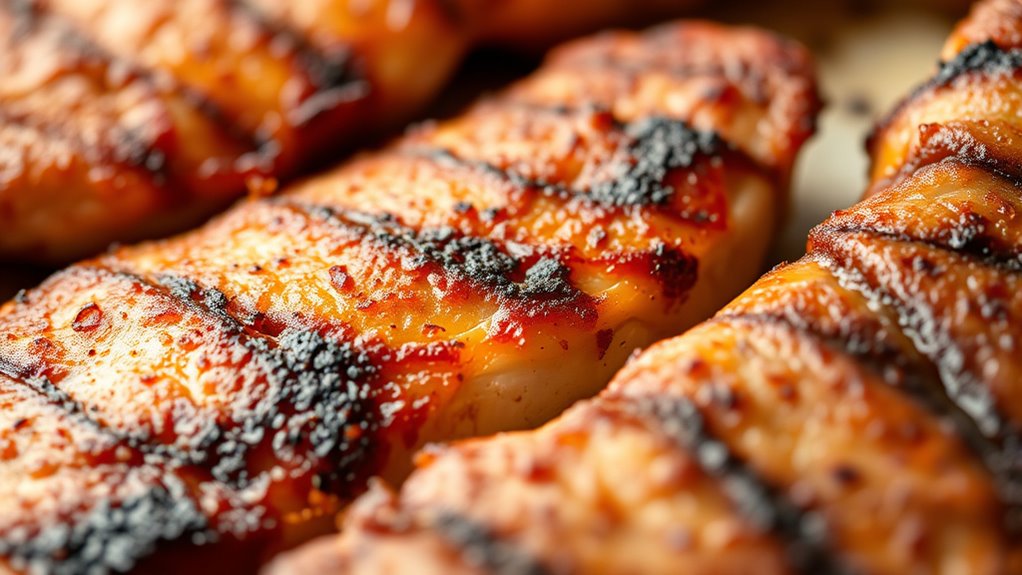Air frying helps retain more protein in meats by cooking quickly with circulating hot air, which minimizes nutrient loss and preserves meat structure. Using moderate temperatures and proper timing ensures proteins stay intact and moisture is maintained. Selecting lean cuts and marinating can also boost protein retention. Avoid overcooking or high heat, as they cause protein denaturation and nutrient depletion. Want to discover how to maximize your meat’s nutritional value? Keep exploring for tips and techniques.
Key Takeaways
- Proper air frying temperature (~375°F/190°C) and timing (10-15 minutes) help preserve meat proteins effectively.
- Using lean cuts and trimming excess fat enhances overall protein retention during cooking.
- Marinating with acidic or enzyme-rich solutions can tenderize meat and protect proteins from denaturation.
- Resting meat post-cooking allows juices and proteins to redistribute, maximizing retention.
- Avoid overcooking by monitoring internal temperature to prevent protein breakdown and nutrient loss.
How Air Frying Affects Meat Protein Content

When you air fry meat, the process helps retain most of its protein content because it uses hot air circulation instead of submerging the meat in water or oil. This method cooks meat quickly and evenly, reducing the loss of nutrients that can occur with other cooking methods. Since you’re not soaking the meat in liquids, the proteins stay concentrated within the meat fibers. Unlike boiling, which can cause some proteins to leach into water, air frying keeps these nutrients intact. The high heat from circulating air denatures proteins just enough for safe consumption without breaking them down excessively. Additionally, proper cooking techniques in air frying help preserve the meat’s natural nutrient profile. Maintaining the nutritional quality of meat through effective cooking methods is essential for health-conscious consumers. Moreover, because air frying minimizes the use of additional fats, it supports a healthier cooking approach that helps retain nutrients. As a result, you get a meal that maintains its original protein levels, making air frying a nutritious and efficient way to prepare meat.
Comparing Protein Retention in Different Types of Meats

When comparing meats, you’ll notice that poultry often retains more protein during air frying than beef. Pork can vary, with some cuts losing more protein depending on the cooking time and temperature. Understanding these differences helps you choose the best options for maximizing protein intake. Additionally, proper cooking techniques can influence protein retention, ensuring you get the most nutritional benefit from your meats. For example, tuning methods can help optimize cooking parameters to preserve nutrients effectively. Incorporating knowledge of sound healing science can also be beneficial in creating a relaxed environment that supports mindful eating and better digestion. Recognizing the importance of glycolic acid benefits for skin, especially in skincare routines, can further enhance overall health and well-being.
Poultry vs. Beef
Poultry and beef differ noticeably in their protein retention after air frying, with several factors influencing how much protein remains in each meat type. Poultry, especially chicken and turkey, tends to retain more protein because it has a higher water content and less connective tissue. Beef, particularly cuts like steaks or roasts, often loses more protein during cooking due to denaturation and moisture loss. The fat content also plays a role; leaner cuts of poultry usually preserve protein better than fattier beef cuts. Additionally, cooking time and temperature impact protein retention—overcooking poultry can reduce its protein content, while beef’s denaturation process varies with cut and doneness. Proper cooking techniques can help maximize protein retention in both meats. The cut type of meat significantly influences protein retention, as some cuts are naturally more prone to moisture loss. The cooking method, such as air frying, can also affect how well protein is preserved during the process. Overall, poultry generally retains slightly more protein after air frying compared to beef.
Pork Protein Loss
Ever wondered how different types of pork, like tenderloin versus bacon, retain their protein after air frying? Pork cuts vary in protein loss due to their fat content and moisture levels. Tenderloin, being lean, generally preserves more protein because it loses less moisture during cooking. Bacon, on the other hand, has higher fat content, which can lead to more protein loss as fat melts away and moisture escapes. Air frying preserves much of the protein in lean cuts, but fattier cuts tend to lose a bit more. The key is to monitor cooking times and temperatures—overcooking can increase protein loss, especially in fattier cuts. Additionally, understanding the role of protein in nutrition can help optimize cooking methods to minimize nutrient loss. Proper cooking techniques ensure maximum retention of nutrients, including protein, in your meats. Understanding the role of protein in nutrition can also help optimize cooking methods to minimize nutrient loss. Proper dog breed knowledge can also inform the best practices for cooking meats suited for different dietary needs, ensuring maximum nutritional value. Overall, choosing leaner pork cuts like tenderloin ensures higher protein retention after air frying.
The Role of Cooking Temperature and Time
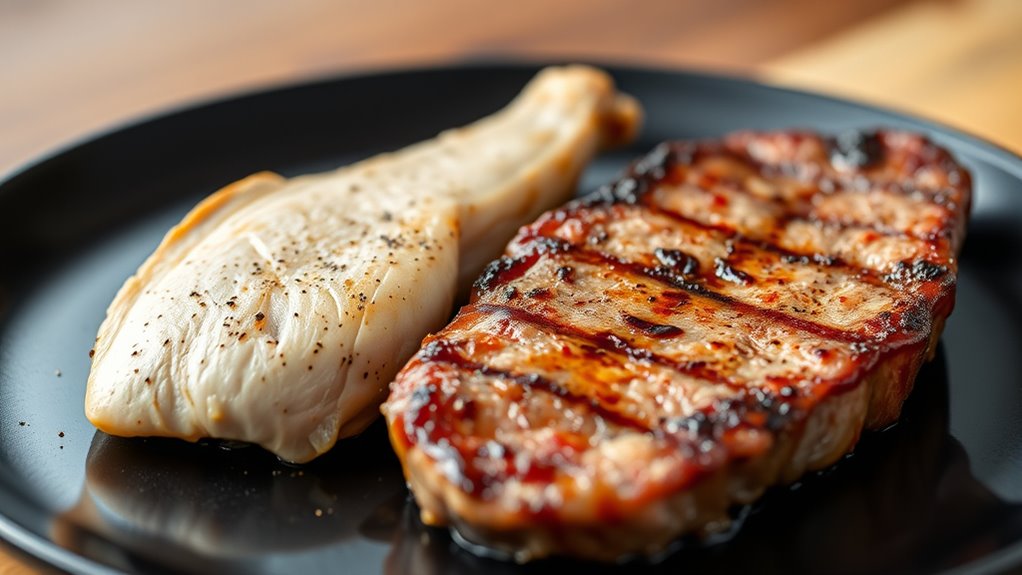
Cooking temperature and time directly influence how much protein your meat retains. If you cook at too high a temperature or for too long, you risk losing valuable nutrients; too low or short, and the meat might not reach safety or desired tenderness. Finding the right balance between time and temperature is key to maximizing protein retention in air-fried meats. Proper sound design techniques can help create educational content that clearly illustrates these concepts through engaging audio explanations.
Temperature’s Effect on Protein
While maintaining ideal protein retention in air-fried meats, temperature and cooking time play crucial roles. Higher temperatures can cause proteins to denature more rapidly, potentially leading to moisture loss and reduced protein content. Conversely, cooking at lower temperatures may preserve more of the meat’s natural proteins, but it might not fully eliminate pathogens. Finding the right balance is essential. Generally, moderate temperatures help maintain the meat’s structure and protein quality. Extreme heat can cause excessive protein coagulation, making the meat tough and reducing its nutritional value. To optimize protein retention, aim for a consistent, moderate temperature that ensures food safety while minimizing protein breakdown. Adjusting temperature based on meat type and thickness is key to achieving the best results. Additionally, understanding AI’s role in food safety can aid in developing better cooking guidelines and safety protocols. Incorporating temperature control techniques and monitoring internal temperature can further enhance nutrient preservation and ensure optimal results. Proper cooking methods that consider meat characteristics contribute significantly to retaining proteins and nutrients during the process.
Cooking Duration Impact
The duration of cooking considerably influences protein retention in air-fried meats, especially when combined with temperature settings. If you cook for too short a time, the meat may remain undercooked, leading to uneven protein preservation. Conversely, overcooking causes protein denaturation and loss, diminishing nutritional value. Maintaining the right cooking duration ensures the meat reaches a safe internal temperature without excessive protein breakdown. Factors like meat thickness and initial moisture content affect how long you should cook. Monitoring internal temperature with a meat thermometer helps prevent over- or under-cooking. Striking the right balance between cooking time and temperature preserves maximum protein content while ensuring safety and tenderness. Properly understanding cooking techniques can further help optimize nutrient retention. Additionally, understanding the recommended formulations for meats and their impact on nutrient preservation can help achieve better results. Being aware of Vetted – Halloween Product Reviews can also inform choices when selecting ingredients or preparing themed meals that fit your dietary goals.
Optimal Time-Temperature Balance
Achieving the ideal balance between temperature and time is essential for maximizing protein retention in air-fried meats. If you cook at too high a temperature, the proteins can denature and lose their structure, leading to moisture loss and dryness. Conversely, cooking too slowly or at a low temperature might not effectively eliminate bacteria and could result in uneven doneness. To optimize protein preservation, you should aim for a moderate temperature that’s high enough to cook quickly but not so high that it damages proteins. Typically, air frying at 375°F (190°C) for 10-15 minutes strikes this balance well for most meats. Adjustments based on meat thickness and type will help you preserve maximum protein while ensuring food safety and tenderness. Additionally, using a supportive cooking environment can help maintain consistent heat distribution, further aiding in protein retention.
How Prepping and Marinating Influence Protein Preservation

Prepping and marinating meats before air frying can substantially influence how well their proteins are preserved. Marinating with acidic ingredients like vinegar or citrus can help tenderize meat and reduce protein denaturation during cooking. Additionally, marinades containing salt or enzymes can improve moisture retention, preventing protein loss and dryness. Properly prepping, such as trimming excess fat and evenly cutting meat, ensures uniform heat distribution, reducing overcooking and protein degradation. Marinating also introduces antioxidants that protect proteins from oxidative damage. However, marinating too long or with highly acidic mixtures may break down proteins excessively, leading to texture changes. Overall, thoughtful prepping and marinating optimize protein preservation by maintaining moisture, structure, and nutritional quality during air frying.
Nutritional Changes During Air Frying: What to Expect

Marinating and prepping meats before air frying not only influence protein preservation but also impact their nutritional profile. During air frying, some water-soluble vitamins, like B vitamins, may decrease slightly due to heat exposure. However, because air frying uses hot air instead of oil, it helps retain more nutrients compared to traditional frying methods. Fat content can change slightly, especially if marinades contain sugars or oils, which may caramelize or break down under high temperatures. Minerals like iron, zinc, and potassium generally stay stable. Overall, air frying preserves most nutrients well, but expect minor losses of sensitive vitamins. You’ll still get a nutritious meal, with the added benefit of less fat and fewer calories, making it a healthier cooking choice.
Tips for Maximizing Protein Retention in Air Fried Meats

To maximize protein retention when air frying meats, focus on gentle handling and proper cooking techniques. Start by choosing fresh, high-quality cuts to reduce moisture loss. Marinate or season your meat beforehand to help lock in juices and proteins. Avoid overloading the air fryer basket, which can cause uneven cooking and protein breakdown. Set the temperature and cook time carefully—high heat can denature proteins, so aim for moderate settings that cook thoroughly without excessive heat. Use a meat thermometer to ensure your meat reaches the right internal temperature without overcooking. Rest the meat for a few minutes after cooking to allow juices, including proteins, to redistribute. These tips help preserve the protein content and ensure your meat stays tender and nutritious.
Common Mistakes That Lead to Protein Loss
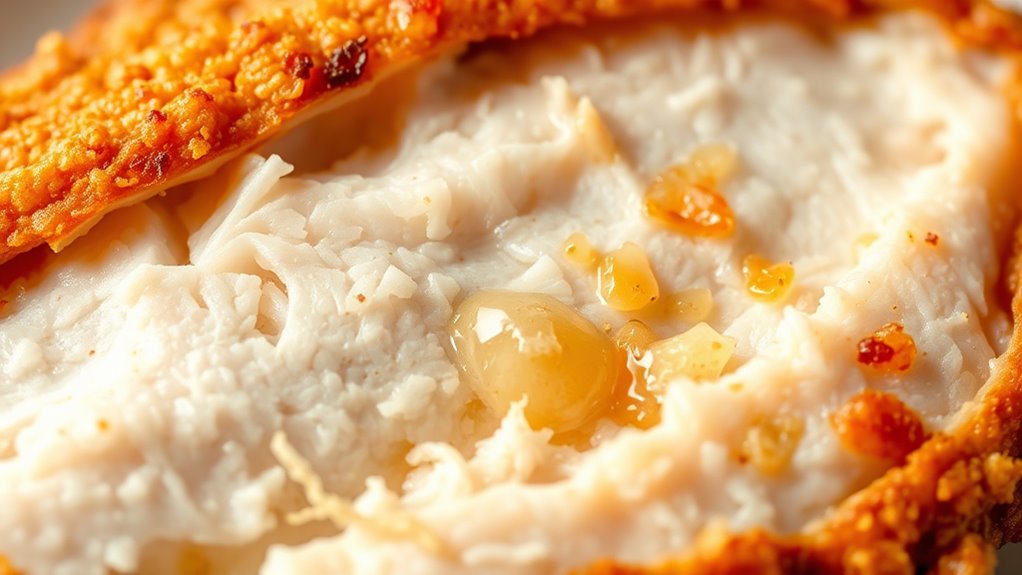
One common mistake that leads to protein loss when air frying meats is cooking at too high a temperature or for too long. Overcooking causes proteins to denature excessively and escape, reducing the meat’s nutritional value. To visualize the impact, consider this table:
| Mistake | Result |
|---|---|
| Cooking too hot | Proteins break down and drip away |
| Overcooking | Loss of juiciness and nutrients |
| Ignoring timing | Increased risk of drying out and nutrient loss |
Avoid these pitfalls by monitoring temperature and cooking time carefully. Using a meat thermometer helps guarantee you don’t overdo it. Proper timing and temperature preserve the meat’s protein content, making your air-fried meats both delicious and nutritious.
The Impact of Thickness and Size of Meat Pieces
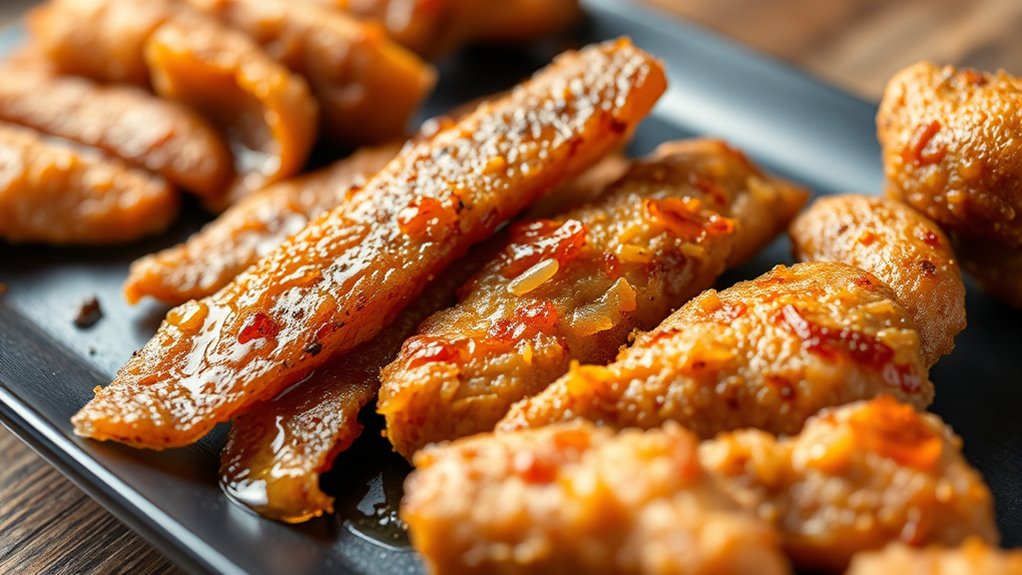
The size and thickness of meat pieces directly influence how evenly they cook in an air fryer. Thicker cuts take longer to reach the desired internal temperature, risking overcooking the exterior while the inside remains underdone. Smaller pieces cook faster and tend to retain more moisture and protein because they spend less time exposed to heat. If your meat pieces are uneven in size, some parts might dry out or lose protein, while others stay undercooked. To maximize protein retention, cut meat into uniform sizes and thicknesses, ensuring even cooking. Thinner cuts cook quickly and help preserve moisture, but be careful not to overcook. Balancing size and thickness allows for precise control, leading to tender, protein-rich results with minimal loss.
Balancing Flavor and Nutrition in Air Fried Dishes
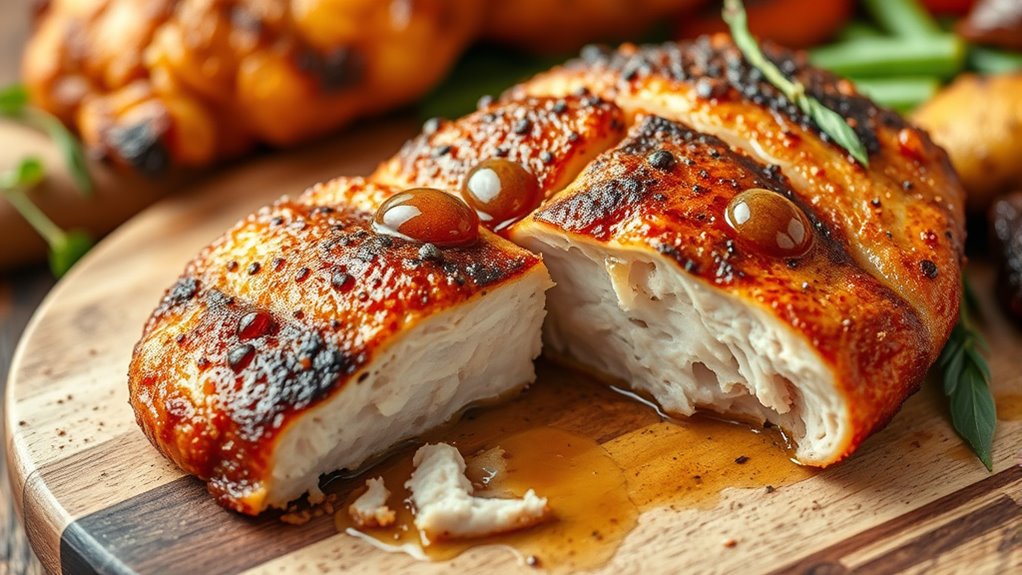
Balancing flavor and nutrition in air fried dishes requires careful selection of ingredients and cooking methods. To maximize both, focus on lean proteins, fresh herbs, and whole-food ingredients. Use marinades or spice blends that add flavor without excess salt or sugar. Adjust cooking times to prevent over-drying, which can reduce nutrient content. Incorporate these strategies:
- Choose nutrient-dense ingredients like vegetables and lean meats
- Use herbs and spices instead of heavy sauces
- Opt for minimal added fats or oils
- Monitor cooking times to preserve vitamins and minerals
Frequently Asked Questions
Does Seasoning Affect Protein Retention During Air Frying?
Seasoning can influence how much protein you retain during air frying. When you apply marinades or seasoning mixes containing salt, acids, or sugar, they can cause some protein loss or change its structure slightly. However, these effects are usually minimal compared to the overall cooking process. To maximize protein retention, consider using simple seasonings and avoid excessive amounts of salty or acidic ingredients before air frying.
How Does Air Frying Compare to Other Cooking Methods for Protein Preservation?
When comparing air frying to other cooking methods, you’ll find it preserves more protein because it uses hot air with little or no added fat. Unlike boiling or frying, air frying minimizes nutrient loss and keeps meats tender. You’ll enjoy juicier, protein-rich results. It’s a quick, efficient option that retains more of the meat’s original nutritional value, making it a great choice for healthy, protein-packed meals.
Can Leftover Air-Fried Meat Be Reheated Without Losing Protein Content?
When reheating leftover air-fried meat, you can preserve most of its protein content by doing it carefully. Use gentle methods like reheating in the oven or microwave at low power, avoiding high heat that can dry out and damage the meat’s proteins. Cover the meat to retain moisture, and don’t overheat. This way, you maintain quality and maximize protein retention, ensuring your leftovers stay nutritious.
Are There Specific Meats That Retain More Protein When Air Fried?
Oh, the irony is sweet—some meats seem to cling to their protein better than others. When air frying, lean cuts like chicken breast and fish generally retain more protein because they’re less fatty and less prone to nutrient loss. You’d think all meats would behave equally, but the truth is, the choice of meat makes a difference. So, go for lean cuts if you want maximum protein retention in your air-fried favorites.
How Does Altitude Impact Protein Retention in Air-Fried Meats?
Altitude can influence how your air fryer cooks meats, but it doesn’t directly affect protein retention. At higher elevations, lower air pressure means your food might cook faster or unevenly, possibly leading to overcooking or undercooking. This could impact protein preservation indirectly if meats are cooked too long or at incorrect temperatures. To maintain ideal protein levels, adjust cooking times and temperatures based on altitude, ensuring meats stay moist and properly cooked.
Conclusion
As you perfect your air frying technique, remember that every choice—from meat type to prep method—can influence protein retention. Imagine slicing into a perfectly cooked piece, juices and nutrients sealed inside, flavor bursting with each bite. Will your next batch preserve more protein than the last? With careful attention to temperature, time, and prep, you’ll reveal the secret to juicy, nutritious meats that satisfy both your taste buds and your health goals. The key is in your hands—are you ready to discover it?
